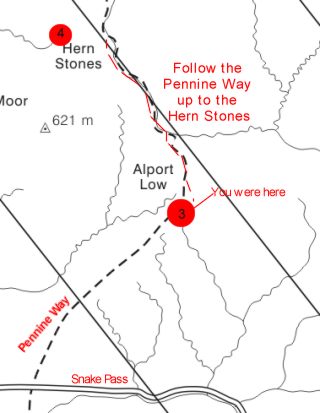
This section of the tour follows the Pennine Way.
The Pennine Way opened in 1965 and was the first long distance path (now called National Trail) in Britain.
The original intention was for the route to be used for long, cross-country journeys, now however, the majority of visitors to the Pennine Way are on day walks.
Sections of the Pennine Way in the Peak District become busy at weekends and during the summer holidays with visitors from Sheffield, Manchester and other towns and cities surrounding the Peaks.
More than 250,000 people walk on the Pennine Way each year - the footpaths must therefore be protected from erosion.

Whilst managing the Pennine Way paths, much care has been taken to ensure work is in keeping with the landscape.
In places, the path has been surfaced with traditional causey flagstones. Many of the stones are made of sandstone from old mills.
This photo right shows how the original surfacing of thin wooden slats has been overlaid with sandstone flags to provide further protection to the path.
Many other techniques of path surfacing and moorland restoration have been tried by the Peak District Management Project.
Well maintained paths protect deep peat soils and vulnerable moorland vegetation from trampling damage.
They also ensure that walkers keep to the specified rights of way and prevents the routes from 'wandering' across the moors.

This photo shows newly delivered flagstones to an area of moorland in need of some protection from walkers.
The stones are dropped by helicopters, the straps used to lower them to the ground can be seen still wrapped around them.
For more information on path surfacing techniques, visit the National Trust's High Peak Estate web site.
More information from the Pennine Way National Trail Office.